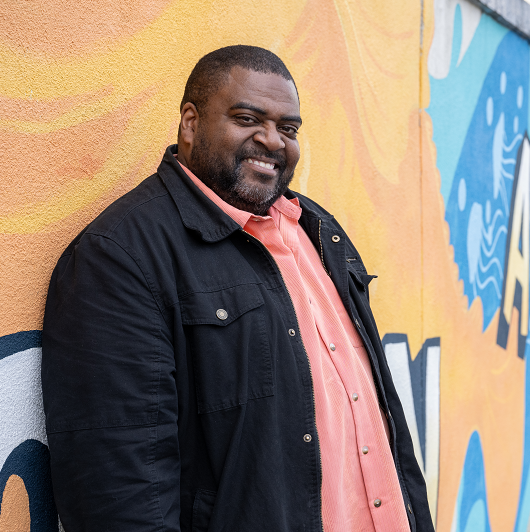Patient Treated for Two Unrelated Cancers in Six Months

December 29, 2023
“When I heard the word cancer, it changed my life,” says Esperanza Herrera-Paredes of the moment she found out the biopsy of a mass found at a routine mammogram was malignant. Little did she know, it would be her first of two unrelated cancers treated with surgery and radiation at Hackensack Meridian Health over the first half of 2023.
In January, Esperanza had surgery at Ocean University Medical Center to treat early-stage breast cancer. In February, as she was recovering at home in Brick, she started getting frequent nosebleeds but kept her focus on her recovery from breast cancer.
In March, despite the nosebleeds and nasal discomfort, she forged ahead with five-day-a-week external beam radiation treatment with Prashant Desai, M.D., radiation oncologist, at Ocean. She tolerated radiation well, heading back to work across the street at Hackensack Meridian Nursing and Rehab – Brick after her daily 15-minute visit.
Nosebleeds Reveal Mass in Sinuses
In early April, as Esperanza was finishing her four-week course of radiation, she had her worst nosebleed yet, lasting three days.
“It was traumatizing,” says Esperanza’s daughter Erika, who, as a nurse, is not easily unnerved. “She was bleeding so much blood was coming out of her tear ducts. We called 911.”
A CT scan found a mass in Esperanza’s sinuses. After blood transfusions to stabilize her, she was released with instructions to follow up with Clifford Chu, M.D., an otolaryngologist (ear, nose, and throat, or ENT doctor) in Brick, for a biopsy.
Dr. Chu diagnosed Esperanza with adenocarcinoma, a rare sinonasal malignancy that he determined was unrelated to her breast cancer. He then referred her to rhinologist Parul Goyal, M.D., an otolaryngologist at Raritan Bay Medical Center sub-specializing in complex disorders of the nose, sinus and skull base. Dr. Goyal saw Esperanza the same day she called.
“I couldn’t be more thankful for Dr. Goyal,” says Esperanza. “Erika and I broke down crying during our first visit because we were so overwhelmed. He could see our desperation and suffering and was very compassionate with us.”
An MRI raised concerns about the placement of the tumor. “Imaging showed it had grown like a tomato and was pressing against, or even possibly infiltrating, Esperanza’s eye socket and skull base,” Dr. Goyal says. “Ultimately, with a cancerous tumor, we want to get the whole thing out, which means negative margins. This can be challenging in the sinus, which is so close to critical structures, and taking more tissue than necessary can come at a high cost to the patient.”
In May, Dr. Goyal successfully removed the tumor endoscopically, using a high-resolution camera and instruments inserted through Esperanza’s nose. Although the tumor had several blood vessels feeding it, it turned out to have roots in a confined region and was only pressing against, not stuck to or pushing through the eye socket or bottom of the skull. This allowed for a complete removal of the tumor with negative resection margins, all without any incisions on the outside of her nose or face.
“I was very impressed with how positive Esperanza was through the entire process,” says Dr. Goyal. “She kept focused on wanting to do everything possible to overcome this. That positve perspective was such an important part of her healing and her recovery during the course of her treatment.”
Volumetric Adaptive Therapy for Sinus Cancer
Esperanza returned to Dr. Desai for a follow-up visit in June, just weeks after her nasal surgery, for radiation treatment for her sinonasal tumor. Dr. Desai recommended volumetric adaptive therapy, a newer form of intensity-modulated radiation therapy that allows the doctor to shape the radiation dose precisely to avoid critical structures nearby.
“Radiation is part of the curative strategy for cancers like this,” Dr. Desai says. “There’s always a concern that microscopic disease can be left behind, so we want to make sure the cancer is gone and does not return. Recent advances in radiation oncology have improved efficacy and decreased toxicity with more precision, so we can target only the tumor site and not nearby areas.”
After healing from her surgery, Esperanza began a six-week course of radiation in July, exactly three months after she finished radiation for breast cancer. Today, she is cancer free, and recently celebrated her 60th birthday with a colorful flowers-everywhere theme.
“I always said God blessed the doctors and their teams, who were so nice and treated me very well,” says Esperanza. “Life threw me challenges, but between my faith, the care that was given to me and my daughter’s support, now I’m okay.”
Next Steps & Resources:
- Meet our sources: Prashant Desai, M.D.,Clifford Chu, M.D., and Parul Goyal, M.D.
- To make an appointment with an oncologist near you, call 800-822-8905 or visit our website.
- Learn more about cancer care at Hackensack Meridian Health
The material provided through HealthU is intended to be used as general information only and should not replace the advice of your physician. Always consult your physician for individual care.






